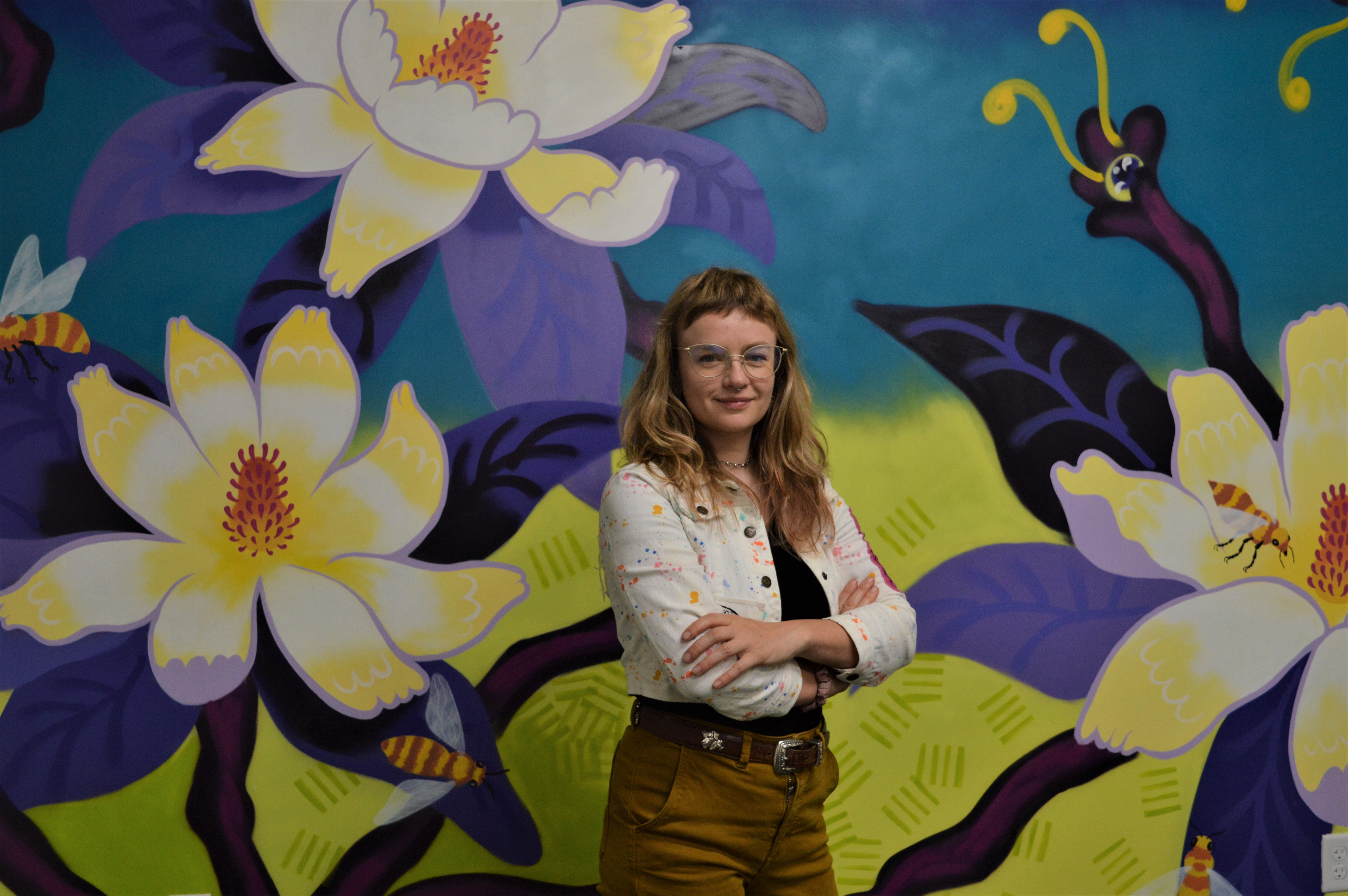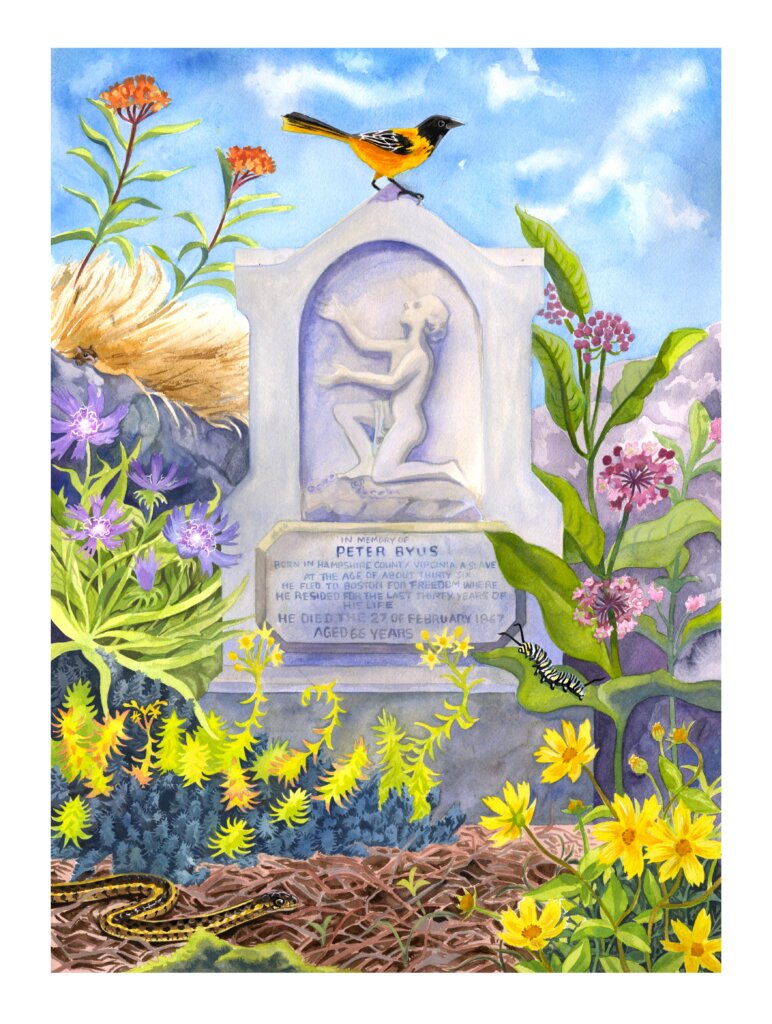Memorializing Nature: A Conversation with Simone Nemes
Jessica Bussmann February 1, 2023 Art

In 2022, we welcomed seven Artists-in-Residence to create original works inspired by their experiences at Mount Auburn. Meet Multi-disciplinary artist (and former Gardening Technician at Mount Auburn) Simone Nemes. This interview was originally published in February 2023.
____________________
You are a multi-disciplinary artist, using painting, mixed media, and printmaking as tools for self-expression. How would you describe your work?
I often feel that my work is quite different project-to-project, and somewhat difficult to classify. Having ADHD has come with its own set of challenges, but the absolute bonus of having this disorder is that my mind is constantly churning out new ideas which feel so tangible. So it’s a matter of parsing through these visions, perhaps putting some ideas on the shelf until I feel like I can properly execute it. But in my practice I have not been shy to explore oil painting, risograph printing, screenprinting, block printing, as well as digital media. I feel that each of these mediums are akin to learning a new language, one that opens up new doors and options for making. In the past I have worked primarily in gouache, which is a type of opaque watercolor, but I don’t classify myself as only a gouache artist. I like to be multidisciplinary- sometimes making silly videos, satirical meditation tracks, and sculpting when I get the chance. I feel especially privileged to be pursuing an MFA at RISD, which has opened up a new world of materials and resources. I have been able to use an Arctec 3D scanner to scan chess pieces which I was then able to 3D print. In the next few years my goal is to focus on mural work so that I can travel and collaborate with artists on wide-reaching projects.
You’ve said that plants and the natural world often inspire your work. You have a degree in Biology and even worked as a gardening technician at Mount Auburn for nearly 3 years? Where/how did your love for the natural world begin?
I was not really a nature kid. I actually hated insects and “bugs.” I struggled in science classes growing up, but when I got to college, I felt this huge urgency to do something about climate change and saving the world. So focusing on STEM seemed like a viable career option and something that could pay the bills. As I studied Biology at Salisbury University on the Eastern Shore of Maryland, I came to work with a dung beetle entomologist and created original scientific illustrations for her. Part of her lab practice involved insect surveys in farm pastures and remote wooded areas. Each day in the field brought up some beautiful insect or plant I had never seen before. Back in the lab, I was able to explore these specimens under high-powered microscopes where I was able to see the incredible artwork of insects. It felt like I was discovering a huge secret about them- their ultimate beauty- which I could only hope to come a fraction close to in my own art.
For your residency at Mount Auburn, you created four seasonal illustrations that feature urns and monuments adorned with native plants and animals. Balancing death with life is a core value here at Mount Auburn. What inspired you to focus on this theme?
I so enjoyed my time at the cemetery and was always really interested in the entirety of the space- the combination of death, life, and nature altogether. During the winter, the gardening team would take long winter walks where we would pole prune the smaller ornamental trees in the cemetery. This was a time to explore the monuments more fully, to revel in the symmetry and the incredible stone masonry techniques that were fashionable during the Victorian era. In the warmer months I would observe all kinds of wildlife and plants- starting in the spring with all the amazing ephemeral flowers that bloom in the dell, nighttime spotted salamander adventures, the spectacular migratory warblers; then in summer the Orioles, hummingbird moths, monarchs, mantises, and all of the other amazing animals, mushrooms, lichen, coyotes. Each day at the cemetery brings new surprises. The contrast of animals and plants eaking out a living, while surrounded by a myriad of monuments that represent not only death but the magnitude of a single person’s life- well, that is quite poetic in my mind.
How did you choose the central image for each piece? What was your process?
The urns and monuments that I chose were first and foremost, ones that I was always interested in by either the artistry or the person who laid underneath them. The Bulfinch monument in the spring illustration is one of the largest urns in the cemetery, as its details are quite beautiful (and fun) to paint. In exploring the idea of notable persons buried, I wanted to pay homage to the many important freedmen and civil war icons that are present in the cemetery. This is why I chose Peter Byus for summer and the sphinx at Bigelow Chapel for the winter painting. Finally, I always loved the story about Margaret Fuller. I think her life was so adventurous given the limitations that she faced. Being one of the first women allowed to use the libraries at Harvard, writing a foundational piece of feminist literature, teaching herself many languages, becoming involved in the 1848 Revolutions in Italy, then meeting a lover in Rome- it just sounds like she lived an incredibly full life. I also think there are many interesting women buried in the cemetery, but often their husbands’ names overshadow their accomplishments. But not with Fuller- her cenotaph is a monument to her accomplishments and her life.

Your illustration for summer features a monument for freedman Peter Byus. Can you tell us about the inspiration for this piece, and how you chose the flora and fauna that adorn it?
Peter Byus has an incredible story and I wanted to feature his simple yet beautiful monument. His epitaph reads: “Born in Hampshire County Virginia, a slave. At the age of about thirty six he fled to Boston for freedom, where he resided for the last thirty years of his life.” Roberto Mighty (former Mount Auburn Artist in Residence) cites Byus’ will in his 2015 documentary. Byus shows an incredible amount of humility and hope in his will which he wrote at the end of his life. He donated part of his estate to the New England Freedmen’s Aid Society, “to the use and benefit of the most necessitous of my own race and color.”
I wanted to tell Byus’ story of hope and migration symbolically in the animals and plants that I selected in the summer painting. The Baltimore Oriole is a migratory bird that overwinters in the Central and South Americas. Every spring, the Oriole makes its trek to Central and Eastern North America where it breeds and raises its young. Similarly, the monarch butterfly makes its journey from Mexico along the coastline of North America where it lays eggs and furthers the species. I added two types of milkweed, plants which the monarch lays its eggs on and depends on to survive. There is hope in all of these stories and life histories.

Comments
Comments for this post are closed